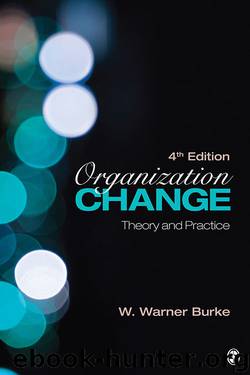Organization Change: Theory and Practice (Foundations for Organizational Science series) by W. Warner Burke

Author:W. Warner Burke
Language: eng
Format: mobi
ISBN: 9781452257242
Publisher: SAGE Publications
Published: 2013-09-30T14:00:00+00:00
Figure 9.3 The Nadler-Tushman Congruence Model for Diagnosing Organizational Behavior
SOURCE: D. A. Nadler and M. L. Tushman, “A Diagnostic Model for Organization Behavior,” 1977, In Perspectives on Behavior in Organizations, edited by J. R. Hackman, E. E. Lawler III, and L. W. Porter, pp. 85–100, New York: McGraw-Hill. Reproduced by permission of the McGraw-Hill Companies.
Resources within the Nadler-Tushman model include capital (money, property, equipment, and so on), raw materials, technologies, people, and various intangibles, such as company name, logo, or brand, which may have a high value in the company’s market.
An organization’s history is also input to the system. The history determines, for example, patterns of employee behavior, policy, the types of people the organization attracts and recruits, and even how decisions are made in a crisis. Recall from Chapter 7 the example of two banks with highly similar backgrounds. When they merged after some 150 years of independence, their respective histories had shaped two entirely different corporate cultures. History is an important variable in the understanding of any organization.
Although strategy is categorized as an input in the model, Nadler and Tushman set it apart. Strategy is the process of determining how the organization’s resources are best used within the environment for optimal organizational functioning. It is the act of identifying opportunities in the environment and determining whether the organization’s resources are adequate for capitalizing on these opportunities. History plays a subtle but influential role in the strategic process.
Some organizations are very strategic; they plan, for example, the rational perspective regarding strategic change delineated by Rajagopalan and Spreitzer (1997; see Chapter 8). Other organizations simply react to changes in their environments or act opportunistically, rather than according to a long-range plan that determines which opportunities will be seized and which will be allowed to pass, similar to the learning perspective described by Rajagopalan and Spreitzer. As Nadler and Tushman (1977) pointed out, however, all organizations have strategies whether they are deliberate and formal or unintentional and informal. Rajagopalan and Spreitzer made the same point.
Outputs
Shifting to the right side of the model (Figure 9.3), we will consider outputs before covering the transformation process. Thus, we shall examine the organization’s environment from the standpoint of both how it influences the system and how it becomes influenced by the system’s outputs.
For diagnostic purposes, Nadler and Tushman (1977) presented four key categories of outputs: system functioning, group behavior, intergroup relations, and individual behavior and effect. With respect to the effectiveness of the system’s functioning as a whole, the following three questions should elicit the necessary information:
Download
This site does not store any files on its server. We only index and link to content provided by other sites. Please contact the content providers to delete copyright contents if any and email us, we'll remove relevant links or contents immediately.
Bad Blood by John Carreyrou(6270)
Rich Dad Poor Dad by Robert T. Kiyosaki(6170)
Principles: Life and Work by Ray Dalio(5951)
Playing to Win_ How Strategy Really Works by A.G. Lafley & Roger L. Martin(5472)
Management Strategies for the Cloud Revolution: How Cloud Computing Is Transforming Business and Why You Can't Afford to Be Left Behind by Charles Babcock(4437)
The Confidence Code by Katty Kay(4033)
Thinking in Bets by Annie Duke(3995)
American Kingpin by Nick Bilton(3501)
Delivering Happiness by Tony Hsieh(3280)
Project Animal Farm: An Accidental Journey into the Secret World of Farming and the Truth About Our Food by Sonia Faruqi(3008)
The Power of Habit by Charles Duhigg(2960)
Mastering Bitcoin: Programming the Open Blockchain by Andreas M. Antonopoulos(2888)
Brotopia by Emily Chang(2888)
The Tyranny of Metrics by Jerry Z. Muller(2844)
I Live in the Future & Here's How It Works by Nick Bilton(2839)
The Marketing Plan Handbook: Develop Big-Picture Marketing Plans for Pennies on the Dollar by Robert W. Bly(2790)
The Content Trap by Bharat Anand(2775)
Building a StoryBrand by Donald Miller(2751)
Applied Empathy by Michael Ventura(2742)
